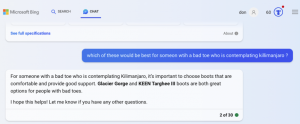Generative AI is Transforming Online Search Right Before Our Eyes
6 Min Read
With the daily avalanche of AI-related news—ranging from mundane marketing jargon to the question of existence itself—it would be easy to miss the sea change that is happening right before our eyes.
But after wading through the avalanche, I’m ready to make a July prediction: within two years, traditional online search and generative AI-powered chat will fully merge into a singular, integrated experience. This merger will dramatically change the entire upper funnel dynamics of ecommerce—and marketing generally—by transforming the traditional multi-step online shopping journey that almost always begins with a search into an ongoing conversational dialog.
This conclusion is based on a close read of what Microsoft and Google are saying and doing, as well as playing around with their respective search engine and large language model (LLM) powered chatbots.
Let’s start with Google. They make their intentions quite clear in this anthem video which states that “AI is moving to the front and center of search.” You can catch a glimpse of what this merged interface might look like in the video, or better yet, sign up for Google Labs and play with the beta version yourself.


Google Labs has merged traditional Google search with a PaLM 2-powered chatbot experience. Note the grey background and disclaimer.
In the example above, I asked Google, “Who makes the best stainless steel cookware?” In the Google Labs’ merged search and chatbot response—which they have branded as a “Search Generative Experience”—they are blending traditional sponsored links at the top, and beneath that, there is a gray zone, intentionally treated distinctly in the UI, for the “Generative AI Experiment” portion of the response. And below the AI-labeled section, the typical search engine results page (SERP) resumes its place.
What’s fascinating to me here is that one of my favorite clients, All-Clad, actually seems to do a bit better in the AI-generated results portion than it does on the rest of the page, or in a plain Jane Google search. In the blended experience, All-Clad’s website gets an image in the second position and a non-sponsored link directly to their D5 stainless steel cookware set. This is a great outcome for them and no doubt a result of the quality of their brand and product.
Now let’s take this same experiment over to the Microsoft side of the world, which is now describing its search engine Bing as “Your AI-powered copilot for the web.” First off, you will notice that “chat” is now embedded as an equal option in the interface alongside Bing’s traditional search in the top navigation – you don’t have to sign up for any beta functionality – this is fully live to the world with one catch. You will eventually hit an “AI wall” that forces you to download Microsoft’s Edge browser if you want to ask the chatbot more than a few questions.
Like Google, they are attempting to use layout and color to distinguish the two types of responses. But they are also inviting users to go ever deeper into dialog with the chatbot, and once you’ve interacted with it, the AI-powered portions of the page become more prominent in the interface with the ever-beckoning search box for the follow-up question.


And once again, All-Clad is faring a bit better in the AI-powered results than in the traditional search results. Also, if you play around with either Google’s SGE or Bing you will notice that the AI-powered results and even how they are being treated in the UI frequently change, indicating that there is a lot of experimentation happening here.
WHAT DOES THIS MEAN FOR CONSUMER BEHAVIOR?
The way humans interact with traditional search engines versus a chatbot is a little different. Let’s take another example. Say I type “most comfortable hiking boots” into regular Google or regular Bing. The results I get are a cacophony of product thumbnail images, some sponsored and some not, and a list of various well-known buying guides.
It’s only now that I realize just how atrocious the user experience of a typical SERP has become. This feels a bit like shopping for hiking boots in Times Square, with a million different images and links screaming for my attention. I am no closer to a decision on which boots to buy. At this point, a typical consumer is going to pick a brand they are familiar with or a product that has lots of 5-star ratings and continue their shopping journey on that website, where that retailer will have the opportunity to showcase their product details in depth and perhaps do a bit of brand storytelling. For a considered purchase they will probably go through two or three different SERPs at different times and multiple retailers (including quite possibly some brick-and-mortar ones) on multiple occasions before a buying decision is made. This process is time-consuming and hard; there’s a reason they call it a shopping journey.
Contrast this same basic experience when I have the opportunity to ask hyper-specific follow-up questions of a generative AI-powered chatbot. Using Bing/GPT4, I type in “most comfortable hiking boots.” The response I get includes a paragraph that lists only five options and, below that, a standard row of sponsored thumbnail images. And below that, a big blue button beckons, “Follow up question?” I type in “Which of these would be best for someone with a bad toe who is contemplating Kilimanjaro?” The response I get back lists only two boots. Within less than 30 seconds, the chatbot narrowed my search dramatically – and got me out of Times Square.


Bing/GPT 4 has narrowed my search to two options.
I tried this same experiment with the PaLM 2-powered Google Labs and had a similar experience. The same follow-up question got me down to a list of only 3 boot options – though notably, they were three completely different boots than Microsoft / GPT 4 recommended.
For the consumer, this may well mean a shorter, more efficient shopping journey as they will have a much higher likelihood of having acquired all the information needed to decide without ever having left the merged search/chatbot experience. By the time a consumer reaches whatever retailer they’ve selected, they will be much closer to a final decision – and they will have bypassed the entire upper funnel of that same retailer’s website (home page, landing pages, category pages, etc).
Today’s search keywords (the lifeblood of ecommerce) will expand into “key questions and key follow-up questions,” and what we have typically thought of as the shopping journey will rapidly evolve into a more succinct shopping conversation.
WHAT’S AN ONLINE RETAILER TO DO?
If you are in charge of an ecommerce website, the challenge here should be obvious. In addition to ranking for regular search, you’ll need to figure out how to rank within the large language models that these chatbots are using.
We recommend you start comparing how your top keywords and your best guess at their corresponding “key conversations and follow-up questions” (branded and non-branded) perform in chatbots versus how they perform in search.
As the cited examples indicate, we see variations in terms of who wins and who loses. It’s a safe bet that what is good for your organic rank in search – a meaningful content strategy and solid technical SEO habits – will also be good for your organic chatbot presence. But going beyond that platitude will take some deep data analysis and longitudinal tracking of both search keywords and chatbot “key follow-up questions” over time.
CONCLUSION
Predicting what companies like Microsoft and Google will do is a pundit’s game, and we know pundits love to be right but are typically wrong. That said, the blending of traditional search and AI-powered chatbots has already happened for Microsoft / GPT 4, and it’s in public beta for Google / PaLM 2 at Google Labs. It’s certainly possible that government regulation (at least in the EU) might slow down the inevitable march of generative AI. But here in the US, with our political environment being what it is, I am highly doubtful Congress can pass any meaningful regulation of generative AI in the near term. And even if they do, it will likely be more focused on other issues, such as exposing how these large language models really work and ensuring they aren’t used for discriminatory purposes.
It should be noted that in Google’s public announcements, they are staking out a measured, “adult in the room” positioning versus Microsoft. While this sounds great from a public relations point of view, it does little to counter the obvious heat Google has been feeling since the launch of ChatGPT last year. I’ve even seen speculation that Microsoft may even try and outbid Google to be the default search engine for Apple’s iOS devices. That would be an epic game-changer.
The more substantial hurdle to this merger happening at scale is simply the computing power required to power these large language models. If it weren’t for that, I’d say this merger would be complete in less than a year. Nevertheless, I’m confident that with the entire focus of tech on AI right now, this technical hurdle will be surpassed quickly.
In this writer’s opinion, it’s not a question of if search and AI-powered chat will merge in everyday usage. It’s merely a question of when. And whenever that happens, whether it’s three weeks or three years from now, buckle up, because everything about how you drive traffic to and revenue from an ecommerce website is about to change.
FURTHER READING:
The AI takeover of Google Search starts now – The Verge
Amazon Plans to Add ChatGPT-Style Search to Its Online Store – Bloomberg

